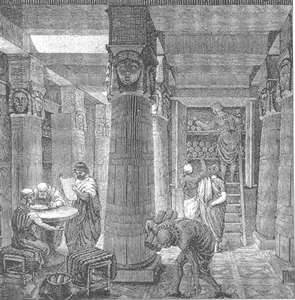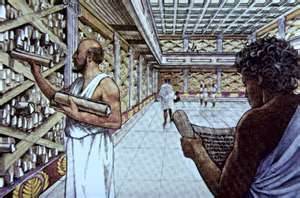The Great Library of Alexandria
The Great Library of Alexandria was a repository for a great many ancient texts. Although the city of Alexandria has survived to the present day, the Great Library has not. The Great Library was a collection of scrolls stored in a collection of buildings in the city named for and created by Alexander the Great.
Ancient sources say that the Great Library opened in either the 4th Century or the 3rd Century B.C., when either Ptolemy I or Ptolemy II was ruling Egypt. One source says that Demetrius of Phaleron, a student of the great Athenian philosopher Aristotle, organized a collection of scrolls into what became the Great Library. The exact layout of the Great Library cannot be verified. Some historians think that, in addition to the scrolls repositories, the Great Library complex had a garden, a reading rooms, several meeting rooms, a few lecture halls, and a Peripatos (or covered) walkway. Most prominent was the bibliothekai, a hall filled with shelves for storing the scrolls, all made of papyrus. Some estimates say that up to 500,000 documents were stored in the Great Library at its height. What is known for certain is that the librarians in charge of the Great Library were aggressive in endeavoring to obtain an ever-expanding collection of knowledge from throughout the known world. One source asserts that crews of ships that docked in Alexandria had to surrender all their written materials to the Great Library so the librarians there could copy out the text and add to the Great Library's wealth of knowledge. With a growing collection of the world's knowledge came a growing number of scholars coming to visit, up to a few hundred at one time. Written on scrolls stored within the shelves of the Great Library were great works of fiction and of nonfiction: astronomy, engineering, geography, mathematics, medicine, and other sciences. One work could encompass several scrolls. As such, the need soon arose for a catalog and for a head librarian. Among the more well-known head librarians were Callimachus (whose Pinakes is thought to be the first library catalog), Apollonius of Rhodes, Eratosthenes, and Aristarchus. (The last two are well-known Greek scientists.) The Great Library was part of a research institute known as the Musaeum, which also included another, smaller library, known as the Serapeum; a large number of study rooms; and a zoo. Such famous scientists as Archimedes and Euclid spent time at the Great Library and the Musaeum. Perhaps the greatest discrepancy is how the Great Library was destroyed.
Another culprit is thought to be Theophilus, who was Patriarch of Alexandria in the 4th Century A.D. The story goes that in 391, a mob encouraged by Emperor Theodosius' efforts to establish the supremacy of the recently canonized Christianity set fire to several "pagan" elements in the city, including the Great Library. Accounts of these events mention the Serapeum much more prominently, adding to the confusion. No less an authority than Edward Gibbon, in the Decline and Fall of the Roman Empire, mentions the destruction of the Great Library and sets it at the feet of Theophilus, as do a few other earlier writers. Another version of the destruction has it coming at the hands of the Muslim army that took the city in 642 A.D. Caliph Omar is said to have directed the army, under the command of a man called Amr, to destroy the Great Library. The first written source of this version of events came 500 years after the "fact." No distinct account of the facts surrounding the loss of the Great Library remains (that we know of). What we know for certain is that the Great Library exists only in written accounts. |
|
Social Studies for Kids
copyright 2002–2024
David White



 Historical discrepancies hamper the collection of a common set of facts about the contents of the Great Library, the way in which the librarians acquired those contents, and even the date and method of the Great Library's destruction.
Historical discrepancies hamper the collection of a common set of facts about the contents of the Great Library, the way in which the librarians acquired those contents, and even the date and method of the Great Library's destruction.  Many sources place the blame squarely on the shoulders of Julius Caesar. As the story goes, Caesar was attacking the city in a dispute with his archival Pompey. In an effort to avoid being cut off by the Egyptian fleet, Caesar set fire to the ships in the harbor and the effort was so successful that it burned not only the ships but also a large part of the city, including the Great Library. In The Alexandrine War, one of Caesar's lieutenants, Hirtius, mentions Caesar's setting fire to the Egyptian ships but says that the city itself wouldn't burn because it was made of stone. The story of Caesar destroying the Great Library is also to be found in Plutarch's Life of Caesar. Subsequent writers retold the Caesar story in their accounts of Roman history.
Many sources place the blame squarely on the shoulders of Julius Caesar. As the story goes, Caesar was attacking the city in a dispute with his archival Pompey. In an effort to avoid being cut off by the Egyptian fleet, Caesar set fire to the ships in the harbor and the effort was so successful that it burned not only the ships but also a large part of the city, including the Great Library. In The Alexandrine War, one of Caesar's lieutenants, Hirtius, mentions Caesar's setting fire to the Egyptian ships but says that the city itself wouldn't burn because it was made of stone. The story of Caesar destroying the Great Library is also to be found in Plutarch's Life of Caesar. Subsequent writers retold the Caesar story in their accounts of Roman history.
